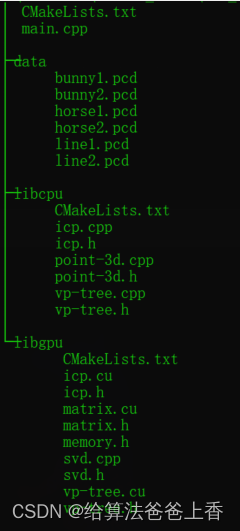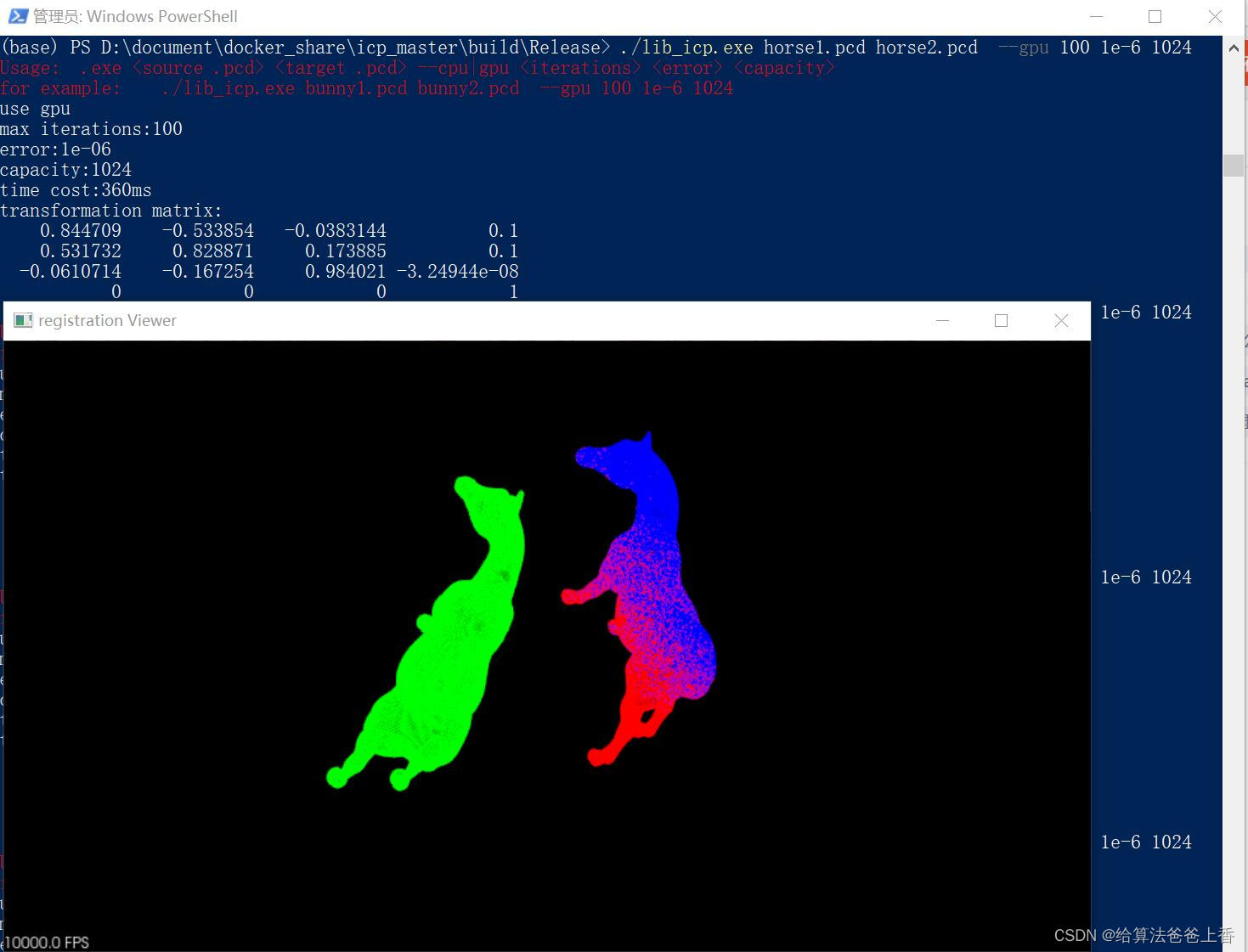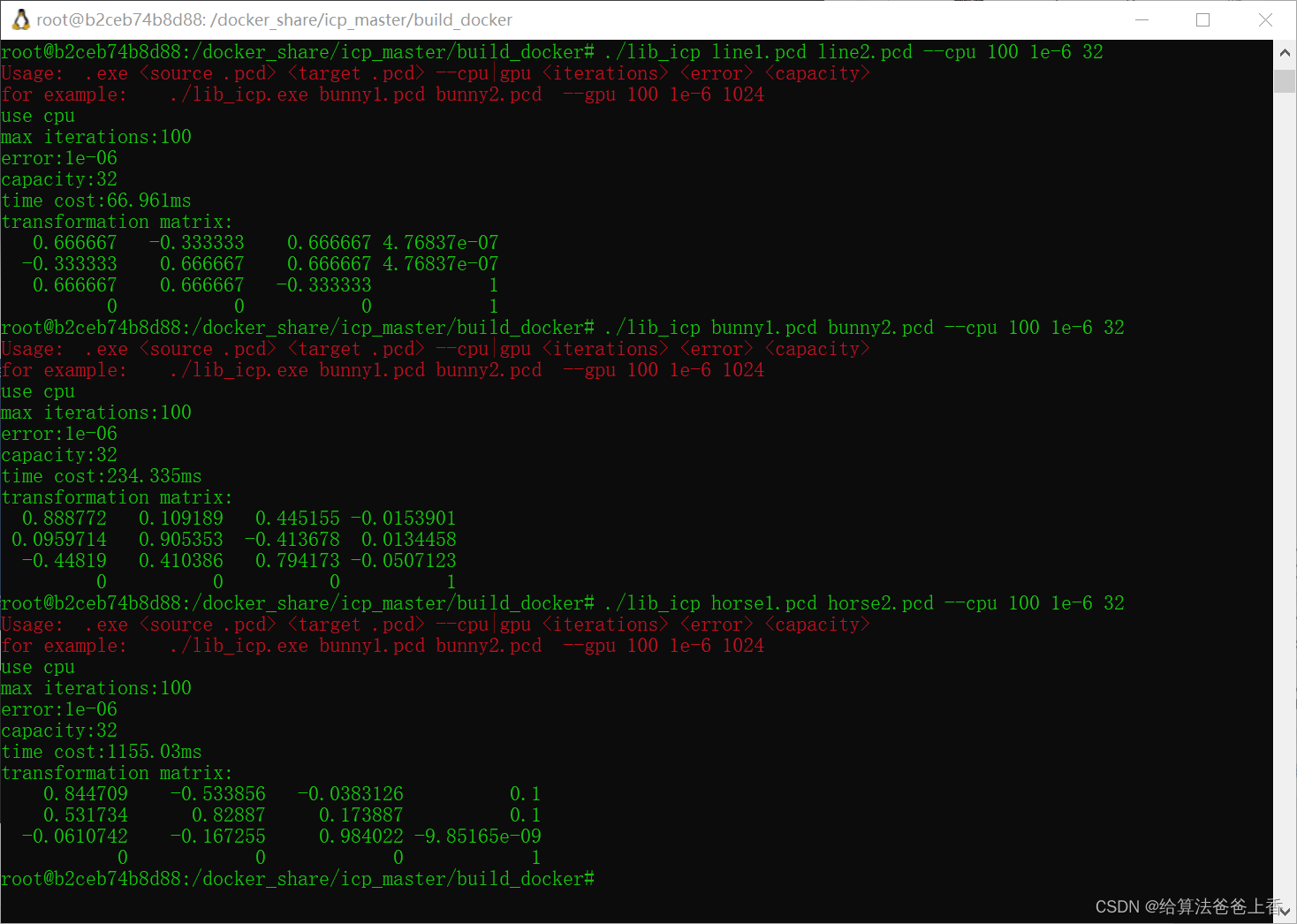LZ之前的文章ICP算法实现(C++) 用C++实现了基础的ICP算法,由于该算法是一种迭代的优化算法,里面含有大量循环操作以及矩阵运算,可以通过使用多线程或者GPU硬件来进行加速,具体分别可以通过OpenMP和CUDA编程实现。这里给出的代码是根据github地址:https://github.com/alex-van-vliet/icp的代码改写的。原作者的代码质量还是不错的,有许多值得借签和学习的地方。但是考虑到使用的第三方库太多不便于配置和使用,LZ把这份代码重构了一下。原作者在代码里造了很多轮子,比如自己实现了Point3D、matrix以及vp-tree(也是一种搜索树,比PCL库中的kd-tree出现时间略晚)的数据结构,但是SVD分解还是调用了Eigen库(可能他也觉得底层实现太麻烦了吧~),LZ把这里面的矩阵结构统一用Eigen库实现了。另外去掉了一些不方便编译的第三方库,并简化了CmakeLists的内容以及程序的结构。如果只编译libcpu库只需依赖Eigen,编译libgpu库的话需要CUDA。
该工程的运行效果如下所示:
lib_icp.exe line1.pcd line2.pcd --cpu 100 1e-6 32 (CPU单核,0ms)
lib_icp.exe line1.pcd line2.pcd --cpu 100 1e-6 32 (CPU多核,2ms)
lib_icp.exe line1.pcd line2.pcd --gpu 100 1e-6 1024 (GPU,81ms)
lib_icp.exe bunny1.pcd bunny2.pcd --cpu 100 1e-6 32 (CPU单核,1407ms)
lib_icp.exe bunny1.pcd bunny2.pcd --cpu 100 1e-6 32 (CPU多核,246ms)
lib_icp.exe bunny1.pcd bunny2.pcd --gpu 100 1e-6 1024 (GPU,156ms)
lib_icp.exe horse1.pcd horse2.pcd --cpu 100 1e-6 32 (CPU单核,12585ms)
lib_icp.exe horse1.pcd horse2.pcd --cpu 100 1e-6 32 (CPU多核,1603ms)
lib_icp.exe horse1.pcd horse2.pcd --gpu 100 1e-6 1024 (GPU,363ms)
Release模式下编译,测试平台为Windows10系统,内存32G,CPU是i7-12700(20线程),GPU是NVIDIA GeForce RTX 3070 Laptop GPU(显存8G,每个block最大线程数为1024),计算的运行时间为三次求平均值。修改后的代码在linux系统也能编译,本人在WSL(Ubuntu20.04)的docker中测试过和Windows本地差别不大,但是调用CUDA版本代码计算结果有误。line1.pcd和line2.pcd点数为10,bunny1.pcd和bunny2.pcd点数为35947,horse1.pcd和horse2.pcd点数为193940;另外LZ调用PCL库计算这三组点云ICP配准耗时分别为0ms,758ms,30550ms。可以看出多核和GPU的加速作用随着点云点数增加优势还是非常明显的,但是点数非常少的话,GPU由于需要和CPU进行数据传输,此时运算速度会不太理想。
自己写了测试main函数,可以直接读取.pcd格式的点云文件(读取二进制储存的pcd文件更为高效,原作者代码是读.txt文件),并添加了时间计算部分和可视化部分,需要另外配置PCL库。
#include <iostream>
#include <pcl/io/pcd_io.h>
#include <pcl/point_cloud.h>
#include <pcl/point_types.h>
#include <pcl/common/transforms.h>
#ifdef _WIN32
#include <ctime>
#include <pcl/visualization/pcl_visualizer.h>
#endif
#ifdef __linux__
#include <sys/time.h>
#endif
#include "libcpu/icp.h"
#include "libgpu/icp.h"
int main(int argc, char* argv[])
{
std::cout << "\033[31mUsage: .exe <source .pcd> <target .pcd> --cpu|gpu <iterations> <error> <capacity>\n"
<< "for example: ./lib_icp.exe bunny1.pcd bunny2.pcd --gpu 100 1e-6 1024\033[0m" << std::endl;
pcl::PointCloud<pcl::PointXYZ>::Ptr cloud_src(new pcl::PointCloud<pcl::PointXYZ>);
pcl::io::loadPCDFile(argv[1], *cloud_src);
pcl::PointCloud<pcl::PointXYZ>::Ptr cloud_tgt(new pcl::PointCloud<pcl::PointXYZ>);
pcl::io::loadPCDFile(argv[2], *cloud_tgt);
bool use_gpu = (std::string(argv[3]) == "--gpu");
if (use_gpu) std::cout << "use gpu" << std::endl;
else std::cout << "use cpu" << std::endl;
size_t iterations = std::atoi(argv[4]);
std::cout << "max iterations:" << iterations << std::endl;
float error = std::atof(argv[5]);
std::cout << "error:" << error << std::endl;
int capacity = std::atoi(argv[6]);
std::cout << "capacity:" << capacity << std::endl;
std::vector<Eigen::Vector3f> p(cloud_src->size());
std::vector<Eigen::Vector3f> q(cloud_tgt->size());
for (size_t i = 0; i < cloud_src->size(); i++)
{
p[i] = cloud_src->points[i].getVector3fMap();
}
for (size_t i = 0; i < cloud_tgt->size(); i++)
{
q[i] = cloud_tgt->points[i].getVector3fMap();
}
#ifdef _WIN32
clock_t start = clock();
#endif
#ifdef __linux__
struct timeval start, end;
gettimeofday(&start, 0);
#endif
auto [transformation, new_p] = (use_gpu ? libgpu::icp(q, p, iterations, error, capacity): libcpu::icp(q, p, iterations, error, capacity));
#ifdef _WIN32
clock_t end = clock();
std::cout << "time cost:" << end - start << "ms" << std::endl;
#endif
#ifdef __linux__
gettimeofday(&end, 0);
std::cout << "time cost:" << (1000000.0 * (end.tv_sec - start.tv_sec) + end.tv_usec - start.tv_usec) / 1000.0 << "ms" << std::endl;
#endif
std::cout << "transformation matrix: \n" << transformation << std::endl;
pcl::PointCloud<pcl::PointXYZ>::Ptr cloud_icp(new pcl::PointCloud<pcl::PointXYZ>);
pcl::transformPointCloud(*cloud_src, *cloud_icp, transformation);
pcl::io::savePCDFile("cloud_icp.pcd", *cloud_icp);
#ifdef _WIN32
pcl::visualization::PCLVisualizer viewer("registration Viewer");
pcl::visualization::PointCloudColorHandlerCustom<pcl::PointXYZ> src_h(cloud_src, 0, 255, 0); //原始点云绿色
pcl::visualization::PointCloudColorHandlerCustom<pcl::PointXYZ> tgt_h(cloud_tgt, 255, 0, 0); //目标点云红色
pcl::visualization::PointCloudColorHandlerCustom<pcl::PointXYZ> final_h(cloud_icp, 0, 0, 255); //匹配好的点云蓝色
viewer.setBackgroundColor(0, 0, 0);
viewer.addPointCloud(cloud_src, src_h, "source cloud");
viewer.addPointCloud(cloud_tgt, tgt_h, "target cloud");
viewer.addPointCloud(cloud_icp, final_h, "result cloud");
while (!viewer.wasStopped())
{
viewer.spinOnce(100);
}
#endif
return 0;
}
工程结构如下:

运行结果截图:


附:调用PCL库ICP配准API的测试代码:
#include <iostream>
#include <pcl/io/pcd_io.h>
#include <pcl/point_cloud.h>
#include <pcl/point_types.h>
#include <pcl/registration/icp.h>
int main(int argc, char* argv[])
{
pcl::PointCloud<pcl::PointXYZ>::Ptr cloud_src(new pcl::PointCloud<pcl::PointXYZ>);
pcl::PointCloud<pcl::PointXYZ>::Ptr cloud_tgt(new pcl::PointCloud<pcl::PointXYZ>);
pcl::io::loadPCDFile(argv[1], *cloud_src);
pcl::io::loadPCDFile(argv[2], *cloud_tgt);
clock_t start = clock();
pcl::IterativeClosestPoint<pcl::PointXYZ, pcl::PointXYZ> icp;
pcl::PointCloud<pcl::PointXYZ>::Ptr cloud_icp_registration(new pcl::PointCloud<pcl::PointXYZ>);
pcl::search::KdTree<pcl::PointXYZ>::Ptr tree1(new pcl::search::KdTree<pcl::PointXYZ>);
pcl::search::KdTree<pcl::PointXYZ>::Ptr tree2(new pcl::search::KdTree<pcl::PointXYZ>);
tree1->setInputCloud(cloud_src);
tree2->setInputCloud(cloud_tgt);
icp.setSearchMethodSource(tree1);
icp.setSearchMethodTarget(tree2);
icp.setInputSource(cloud_src);
icp.setInputTarget(cloud_tgt);
icp.setEuclideanFitnessEpsilon(1e-6);
icp.setMaximumIterations(100);
Eigen::Matrix4f transformation = Eigen::MatrixXf::Identity(4, 4);
icp.align(*cloud_icp_registration, transformation);
clock_t end = clock();
std::cout << end - start << "ms" << std::endl;
Eigen::Matrix4f transformation_icp = icp.getFinalTransformation();
std::cout << transformation_icp << std::endl;
std::cout << "ICP has converged:" << icp.hasConverged() << " score: " << icp.getFitnessScore() << std::endl;
pcl::transformPointCloud(*cloud_src, *cloud_icp_registration, transformation_icp);
pcl::io::savePCDFileBinary("icp.pcd", *cloud_icp_registration);
return 0;
}
代码和数据集下载地址如下:
工程下载链接








 本文介绍了作者对ICP算法的C++实现进行了重构,移除第三方库并优化了多线程和GPU加速。实验结果显示,多核CPU和GPU在处理大规模点云时有显著优势,但在少量点云时GPU性能受限于数据传输。
本文介绍了作者对ICP算法的C++实现进行了重构,移除第三方库并优化了多线程和GPU加速。实验结果显示,多核CPU和GPU在处理大规模点云时有显著优势,但在少量点云时GPU性能受限于数据传输。

















 1175
1175












